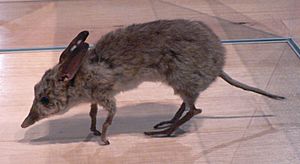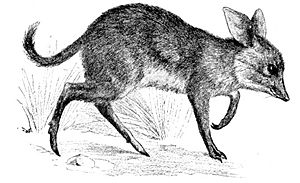Pig-footed bandicoot facts for kids
Quick facts for kids Pig-footed bandicoot |
|
|---|---|
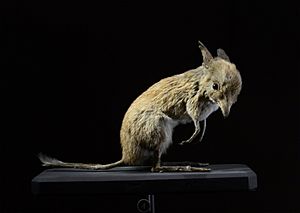 |
|
| A C. yirratji specimen at the Grande Galerie de l'Évolution | |
| Scientific classification |
|
| Kingdom: | Animalia |
| Phylum: | Chordata |
| Class: | Mammalia |
| Infraclass: | Marsupialia |
| Order: | Peramelemorphia |
| Family: | †Chaeropodidae Gill, 1872 |
| Genus: | †Chaeropus Ogilby, 1838 |
| Type species | |
| Perameles ecaudatus Ogilby, 1838
|
|
| Species | |
|
|
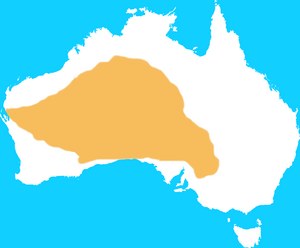 |
|
| Historic pig-footed bandicoot range in orange | |
The Chaeropus, also called pig-footed bandicoots, were small mammals. They became extinct during the 1900s. These unique marsupials had very thin legs. But they could still move super fast!
There were two types of these marsupials. They lived in thick plants on Australia's dry plains. Later, they were only found in inland desert areas. The last time one was seen was in the 1950s. Now, they are believed to be completely gone.
Contents
What are Pig-footed Bandicoots?
The pig-footed bandicoot was a special type of marsupial. Scientists have only 29 specimens left in museums. These animals looked a bit like small bandicoots or kangaroo-rats. They were very small and delicate. They were about the size of a young rabbit or a kitten.
Unique Feet and Body
Their front feet looked like a pig's hooves. Their back legs were like a horse's. They were about 23–26 cm long. Their tail was 10–15 cm long.
The front feet had two working toes. These toes had hooves, just like a pig or a deer. Their back feet had a large fourth toe with a strong claw. This claw looked like a tiny horse's hoof. The other toes were tiny and not very useful for walking. The fused second and third toes were only used for grooming.
They had wide heads and a long, thin snout. Their fur was rough and straight. It was not spiky. Their fur color varied. It could be grizzled grey, fawn, or orange-brown. Their belly and underside were white. The fur on their ears was chestnut colored.
Female pig-footed bandicoots had eight nipples. Their pouch opened backwards. This is different from kangaroos, whose pouches open forwards.
Where They Lived
The two species lived in western New South Wales and Victoria. They also lived in the southern Northern Territory, South Australia, and Western Australia.
The Chaeropus ecaudatus lived in the dry southern parts of Australia. This included southwest Australia. The C. yirratji lived in sandy areas. These stretched from Western Australia to the deserts in central Australia.
They lived in many different places. These included grassy woodlands, grasslands, and dry, sandy areas. Even though they lived in a wide area, they were never found in large numbers.
Scientists have found 29 complete specimens in museums. Early records show they were sometimes common in central and western Australia. For example, a specimen was found in 1818 on the Peron Peninsula.
The last time a Chaeropus was recorded in Southwest Australia was in 1898. This was around the time many Australian mammals disappeared.
Ancient Homes
Evidence from old bones shows they lived in an even bigger area long ago. This was during the Holocene and Pleistocene epochs. Bones were found in Mammoth Cave (Western Australia) in the early 1900s. They were also found in eastern Queensland. This shows that their habitat changed. Rainforests became open grasslands, which they liked.
Why They Disappeared
Indigenous Australian stories say that pig-footed bandicoots were rare even before Europeans arrived. They were already declining in the mid-1800s. Only a few specimens were collected in the late 1800s. Most came from northwestern Victoria. Some also came from dry areas in South Australia, Western Australia, and the Northern Territory.
By the early 1900s, they were gone from Victoria and southwest Western Australia. The last confirmed specimen was collected in 1901. By 1945, C. ecaudatus was extinct. It had vanished from South Australia. C. yirratji was only found in a small part of central Australia. However, Aboriginal people say C. yirratji survived until the 1950s. They were seen in the Gibson Desert and Great Sandy Desert of Western Australia.
What Caused Their Extinction?
We are not entirely sure why they disappeared. Two harmful animals, the fox and the rabbit, had not yet arrived in southwest Western Australia when the bandicoots vanished from there. Feral cats were common, which might be one reason.
It is more likely that two big changes to their habitat caused their decline:
- Changes in land management: For thousands of years, Aboriginal people used to burn small areas of land. This created a mix of new plant growth and older plants for shelter. But by the 1800s, the Aboriginal population had dropped a lot. They were also often not allowed to continue their traditional land practices.
- New animals: After the decline of Aboriginal people, many sheep and cattle were brought in. These animals changed the soil, plant growth, and food availability.
Some scientists also think a disease might have played a role. This disease could have wiped out the bandicoot populations. They might not have had any protection against it.
An Aboriginal survey in 1988 found that the animal had not been seen in southern areas for about 70 years. But it had lasted longer in the central desert regions.
Behavior and Life
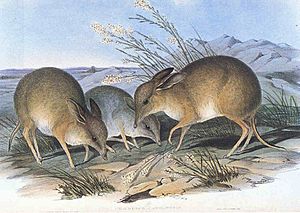
Few naturalists got to watch these animals closely. One report said they moved "like a broken-down hack in a canter." This meant they seemed to drag their back legs.
However, Aboriginal people knew them well. They said that if disturbed, the bandicoots could run very fast. They would break into a smooth, galloping sprint.
Pig-footed bandicoots moved in a special way. Their long, thin legs made them look like a large grazing animal, like an African antelope. Their unique feet helped them escape danger quickly.
They were solitary animals, meaning they lived alone. They were also nocturnal, which means they were active at night. During the day, they slept in shelters. In the evening, they came out to find food. They used their excellent sense of smell to find meals.
Depending on where they lived, they used different shelters. In wooded areas and grasslands, they used hollow logs or nests made of grass. In dry, treeless areas, they dug short, straight burrows with a nest at the end.
Scientists looked at what was in their stomachs and their teeth. It seems pig-footed bandicoots mostly ate plants. They were the most plant-eating of all bandicoots. They likely ate leaves, roots, and grasses. Some reports also say they ate grasshoppers, ants, and termites. In captivity, they were seen drinking "a good deal of water."
Scientists believe they bred between May and June. It's thought that twins were common. Based on the size of their pouch, they probably did not carry more than four young at a time.


